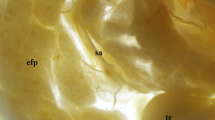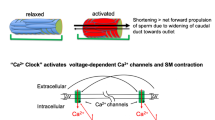Summary
The distribution of adrenergic nerves to the male reproductive ducts were studied by applying the highly specific method of Falck and Hillarp for the cellular demonstration of the adrenergic transmitter. In rats, guinea-pigs, and rabbits, the ducts of the testis and the caput epididymidis were found to lack adrenergic varicose terminals, as they also lack cholinesterase positive structures. Adrenergic terminals extend in the vas deferens and epididymis from the prostatic end as far as the upper mid-corpus level of the ductus epididymidis, occurring in the muscle layers and, except in the rat, in the lamina propria. In the cat, ductuli efferentes and caput epididymidis also receive an adrenergic innervation.
Similar content being viewed by others
Literature
Battaglia, E.: Sulla motilità dell'epididimo del ratto in colture organotipiche rotanti. Arch. ital. Anat. Embriol. 63, 47–56 (1958).
Campenhout, E. van: Les relations nerveuses de la glande interstitielle des glandes génitales chez les mammifères. Rev. canad. Biol. 8, 374–429 (1949).
Corrodi, H., and N.-Å. Hillarp: Fluoreszenzmethoden zur histochemischen Sichtbarmachung von Monoaminen. 1. Identifizierung der fluoreszierenden Produkte aus Modellversuchen mit 6,7-Dimethoxyisochinolinderivaten und Formaldehyd. Helv. chim. Acta 46, 2425–2430 (1963).
—: Fluoreszenzmethoden zur histochemischen Sichtbarmachung von Monoaminen. 2. Identifizierung der fluoreszierenden Produkte aus Dopamin und Formaldehyd. Helv. chim. Acta 47, 911–918 (1964).
—, and G. Jonsson: Fluorescence methods for the histochemical demonstration of monoamines. 3. Sodium borohydride reduction of the fluorescent compounds as a specificity test. J. Histochem. Cytochem. 12, 582–586 (1964).
Crabo, B.: Studies on the composition of epididymal content in bulls and boars. Acta vet. scand. 6, Suppl. 5, 1–94 (1965).
Falck, B.: Observations on the possibilities of the cellular localization of monomaines by a fluorescence method. Acta physiol. scand 56, Suppl. 197, 1–25 (1962).
—, N.-/0A. Hillarp, G. Thieme, and A. Torp: Fluorescence of catecholamines and related compounds condensed with formaldehyde. J. Histochem. Cytochem. 10, 348–354 (1962).
-, and Ch. Owman: A detailed methodological description of the fluorescence method for cellular localization of biogenic monoamines. Acta Univ. Lund, sectio II, no 7 (1965).
—, and N. O. Sjöstrand: Peripherally located adrenergic neurons innervating vas deferens and seminal vesicle of the guinea-pig. Experientia (Basel) 21, 98–100 (1965).
Jacobowitz, D., and G. B. Koelle: Histochemical correlations of acetylcholinesterase and catecholamines in postganglionic autonomic nerves of the cat, rabbit, and guinea-pig. J. Pharmacol. exp. Ther. 148, 225–237 (1965).
Koelle, G. B.: The histochemical identification of acetyl-cholinesterase in cholinergic, adrenergic and sensory neurons. J. Pharmacol. exp. Ther. 114, 167–184 (1955).
—, and J. S. Friedenwald: A histochemical method for localizing cholinesterase activity. Proc. Soc. exp. Biol. (N.Y.) 70, 617–622 (1949).
Kuntz, A., and R. E. Morris jr.: Components and distribution of the spermatic nerves and the nerves of the vas deferens. J. comp. Neurol. 85, 33–44 (1946).
Muratori, G.: Osservazioni preliminari sull'azione dell'adrenalina e dell'acetylcholina sui movimenti del canale dell'epididimo del ratto. Boll. Soc. ital. Biol. sper. 32, 248–249 (1956).
—, e S. Contro: Osservazioni sui movimenti del canale dell'epididimo. Boll. Soc. ital. Biol. sper. 27, 538–539 (1951).
Norberg, K. -A., and B. Hamberger: The sympathetic adrenergic neuron. Some characteristics revealed by histochemical studies on the intraneuronal distribution of the transmitter. Acta. physiol. scand. 63, Suppl. 238, 1–42 (1964).
Owman, Ch., and N. O. Sjöstrand: Short adrenergic neurons and catecholamine containing cells in vas deferens and accessory male genital glands of different mammals. Z. Zellforsch. 66, 300–320 (1965).
Risley, P. L.: Hormone effects on the in vivo contractile behavior of the ductus epididymis of the rat. Anat. Rec. 133, 329–330 (1959).
—: Physiology of the male accessory organs. In: Mechanisms concerned with conception (ed. C. Hartman), p. 83–88. London: Pergamon Press 1963.
—, and C. N. Skrepetos: Histochemical distribution of cholinesterases in the testis, epididymis and vas deferens of the rat. Anat. Rec. 148, 231–249 (1964).
Sjöstrand, N. O.: The adrenergic innervation of the vas deferens and the accessory male genital glands. Acta physiol. scand. 65, Suppl. 257, 1–82 (1965).
Timofeew, D.: Zur Kenntnis der Nervenendigungen in den männlichen Geschlechtsorganen der Säuger. Anat. Anz. 9, 342–348 (1894).
Velde, R. L. van de, and P. L. Risley: The origin and development of smooth muscle and contractility in the ductus epididymidis of the rat. J. Embryol. exp. Morph. 11, 369–382 1963
Author information
Authors and Affiliations
Additional information
For skilful technical assistance we are grateful to Mrs. Ulla Flyger and Miss Berith Hansson. The investigation has been supported by a research grant (B 66-257) from the Swedish Medical Research Council.
On sabbatical leave from the Biology Department, University of Oregon, Eugene, Oregon, with the aid of a Senior Research Fellowship from the National Council of Child Health and Human Development, National Institutes of Health, U.S. Department of Health, Welfare and Education. The use of facilities of the Department of Physiology I, Karolinska Institutet, with the kind permission of Professor U. S. von Euler and Research Docent R. Eliasson during the course of this study also is greatly appreciated.
Rights and permissions
About this article
Cite this article
Norberg, K.A., Risley, P.L. & Ungerstedt, U. Adrenergic innervation of the male reproductive ducts in some mammals. Zeitschrift für Zellforschung 76, 278–286 (1966). https://doi.org/10.1007/BF00343103
Received:
Issue Date:
DOI: https://doi.org/10.1007/BF00343103




